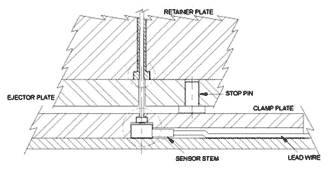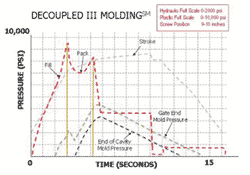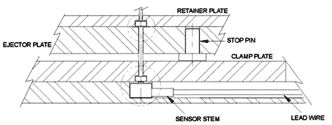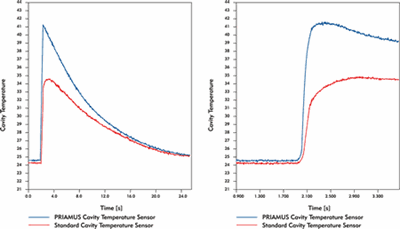Adding Value to Your Mold
Moldmaking shops must evaluate the need for a pressure transducer in an injection mold to assist them in gaining valuable information as the mold is developed.
Moldmakers in today's competitive environment are called upon many times to be more than skilled professionals at building quality tooling for a customer. Because they are asked at times to be a plastics expert ("What shrink should we use?"), process technician ("What mold temperatures do we need to run and how fast?") and automation inventor ("Is there another way we can get the part out of the mold?), moldmakers need basic knowledge on the benefits of pressure sensors, options of styles and placement within the mold. The adding of value to customers is important in today's competitive environment.
The Purpose of a Pressure Sensor
The pressure sensor measures the plastic somewhere between the machine nozzle to the cavity area as the part is filled, packed, held and cooled. Sensors can be placed in the machine nozzle, hot runner systems, cold runner systems and the cavity area of a mold. However, we will focus on the cavity area.
The sensor reads the pressure at the location it is placed in the runner system or cavity area, and that information is recorded on a monitoring system. This information, depending on auxiliary equipment, can be used to adjust the molding press real time, be reviewed after the mold trail or to troubleshoot problems that develop during a production run. Also, with the information collected, parts can be reproduced on a machine-independent basis.
Pressure Sensor Options
There are two styles of pressure sensors being used in molds today—flush mount and indirect. The flush mount uses a sensor which is installed close to the cavity by machining an installation hole from behind the cavity to allow the sensor to be flushed with the cavity surface (see Figure 1). Then, cabling is brought out through the mold, as appropriate, to the connector on the outside surface of the mold. One advantage of this type of sensor is that it does not see the forces of ejection; however, in some high-temperature applications it can be damaged, which makes the installation problematic.
The indirect sensor comes in two configurations, the slide and the button. These sensors use the force exerted by plastic on an ejector or stationary pin, which transmits the force to the sensor which is either in the ejector plate or the clamp plate of the mold. Indirect sensors are most commonly placed in the ejector plate of a mold beneath an existing ejector pin. However, in high-temperature applications or when low force sensors are used for small pins, many times the sensors are placed in the clamp plate of the mold and the pin is used through an ejector sleeve or uses a transfer pin (see Figures 2 and 3, page 26). The benefits of the transfer pin are that an existing ejector pin can be used while the sensor is not exposed to the forces of ejection. Also, in fast-cycle, high-speed ejection situations the sensor is not exposed to the rapid acceleration and deceleration of the ejector plate.
The size of the ejector pin that sits on top of the sensor will dictate what sensor size will be used. It is best for the mold designer to use the same size pin for all sensors in a mold to eliminate setup or calibration errors by the user. Since a pin is used to transfer the pressure of the plastic to the sensor, one size pin will not work for all applications.
The button-style sensor is held captive by its pocket. To move this sensor around in a mold, plates would have to be separated or provisions would have to be designed in advance. Usually when this style is used, a sensor is placed where required.
Depending on types of button sensors and where they might be located in a mold, collector pockets for the cable may need to be added in the mold plates. The button sensor is more reliable because of its pocketing and is preferred whenever possible.
The slide type, which is no longer in wide usage, can be removed from the mold while in the press. The downside is that the slide sensor can move in its pocket and not give an accurate reading.
Where to Locate and Why
Sensors
It is important that pressure sensors are properly located to get the maximum amount of information for molders. While there are many specific exceptions to the rule, sensors for process monitoring should be located near the last one-third of the cavity to fill. Sensors for controlling the process by transferring the press should be in the first one-third of the cavity. For very small parts, sometimes the sensor is located in the runner system. However, this is a compromise that does not allow gate seal to be observed using the sensor. It is important to realize that when a short-shot is developed, zero pressure at the end-of-cavity is present; the end-of-cavity sensors are key for sensing short-shots and automated part containment. Today, using digital sensors makes it easy to put sensors in every cavity and simply have one network wire from the mold to the press. This allows 100 percent insurance against short-shots being delivered to the customer by simply installing the sensors at the end of cavity without any further process control interface to the machine.
Pockets
Mold designers or moldmakers will have to determine during the design process where to place pockets for the sensor, cabling and exiting from the mold. It is not desirable for moldmakers to let the cable or wire exit the mold and be free to move around. The connector should be fastened to the mold base and an additional cable used to connect the mold to the molding press or auxiliary equipment.
Mold Tryout
One of the biggest values provided for and by moldmakers is the rigorous mold tryout using the instrumented mold. This allows a process to be set up and optimized on the first or second tryout and then used for every subsequent tryout to minimize the number of trials necessary. Once this is done, and the mold has been qualified with correct dimensions and capabilities, the documented process can accompany the mold to molders and be set up. Mold builders who understand this process help molders make the transfer directly to their production equipment as part of the value of the mold. This could be handled directly by mold builders, or in some cases, by a third party who has the equipment and understands the methodology. This truly gives mold build a new set of values to molders and, ultimately, to OEMs who own the tool.
The Bottom Line
From the standpoint of OEMs, the pressure sensor can help the bottom line by being profitable. Getting the product to market, being competitive in price and supplying quality is what the marketplace demands. OEMs also may want the flexibility to move their molds from one press to another or one location to another.
In this process, moldmakers are the first link of the chain that takes the product from concept to market. Their knowledge of the molding process is part of the input into the mold design. Moldmakers are selling this expertise to their customer.
Molders are selling their press time. Someone, somewhere along the line has bid the needed time to test a new or refurbished mold before going into production. All involved are working on tight timelines; it is important for molders to have at their hands the best technology available to assist them in setting the mold and gaining valuable information as the mold is cycled through a short-shot series and then into a mold trail. Information gained here can then be transferred to OEMs.
Because of this, moldmakers are becoming jacks-of-all-trades in the plastics industry. Those in the business over the years have seen their share of problems even with quality built tooling. They hear from customers that the mold isn't filling well, the critical dimensions are not being met and the list goes on. Often they are not able to be at the mold trail to see and learn about processing in a mold. Molders can supply valuable information to moldmakers from data gathered from a pressure sensor (see Figure 4).
Through all of these struggles, each link of the chain needs to maintain the commitment of meeting delivery and making a fair profit. The pressure sensor is not a cure to every mold that is built, but it does see internally what is going on with the plastic once it leaves the molding machine and finishes in the cavity area.
It is proactive for all moldmakers to understand what the benefits of pressure sensors are for the injection mold. Molders who embrace the use of mold pressure sensors as the center of a smart mold can generate new value to their customer and add overall capability to the value stream. They also add knowledge to their mold build for future projects. Even though the moldmaker is not the one to decide whether to place one into a mold, they should be able to share their thoughts on the need if asked by their customer.
Should a new mold not require a sensor, it is a good idea to think ahead to a mold that might have one added in the future. Every mold built does not need a pressure sensor, but every mold can reap the benefits if the information the pressure sensor gives to molders is shared with moldmakers.
Related Content
Editorial Guidelines: Editorial Advisory Board
The Editorial Advisory Board of MoldMaking Technology is made up of authorities with expertise within their respective business, industry, technology and profession. Their role is to advise on timely issues, trends, advances in the field, offer editorial thought and direction, review and comment on specific articles and generally act as a sounding board and a conscience for the publication.
Read MoreMold Builder Uses Counter-Intuitive Approach for Mold Challenges
Matrix Tool Inc. answers customers’ hard questions with creative solutions for cavity spacing, tool sizing, runner layout and melt delivery that reveal the benefits of running in a smaller press size at lower cavitation but higher yield.
Read MoreMaking Quick and Easy Kaizen Work for Your Shop
Within each person is unlimited creative potential to improve shop operations.
Read MorePredictive Manufacturing Moves Mold Builder into Advanced Medical Component Manufacturing
From a hot rod hobby, medical molds and shop performance to technology extremes, key relationships and a growth strategy, it’s obvious details matter at Eden Tool.
Read MoreRead Next
The Moldmaker’s Role in Controlling the Molding Process
How the toolmaker/mold designer can make the best choices when it comes to in-mold cavity sensing and control; how to do a good installation; basic functionality of the sensors; and, post installation care.
Read MoreHow to Use Strategic Planning Tools, Data to Manage the Human Side of Business
Q&A with Marion Wells, MMT EAB member and founder of Human Asset Management.
Read MoreHow to Use Continuing Education to Remain Competitive in Moldmaking
Continued training helps moldmakers make tooling decisions and properly use the latest cutting tool to efficiently machine high-quality molds.
Read More










.jpg;maxWidth=300;quality=90)





















